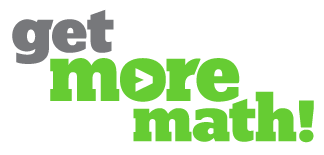How Get More Math
Breaks the Math Forgetting Cycle

Success in mathematics requires not just understanding of concepts, but also regular practice. Educators often face the challenge of finding effective ways to reinforce mathematical concepts and ensure long-term retention. Enter retrieval practice–a scientifically proven method to enhance the way students learn and make learning stick.
Get More Math is a powerful and innovative tool that aims to revolutionize math education by breaking the math forgetting cycle, the concept that we lose information over time if we don’t try to retain it (Wittman, 2018). With targeted practice that combines new material with spiral review, students are achieving enhanced long-term retention of math skills. Research has shown that if learners spread out their study of a topic, returning to it periodically over time, they remember it better (Brown et al., 2014).
Even the most experienced math teachers have had students who ace unit tests, but later struggle with the same content on the final exam or have a hard time grasping more advanced concepts because they have forgotten previous foundational learning. With Get More Math, as teachers choose the types of problems they want students to practice and master, the program integrates a daily spiral review of previously learned concepts to ensure long-term retention. The teacher remains the primary driver of instruction and can continue to ensure that all students have the opportunity to master grade-level standards. As a result, students won’t be “stuck” in a cycle of working on standards below their grade level, which can actually hurt students and exacerbate racial inequities. (TNTP, 2021). Get More Math allows for learning acceleration, as the teacher can start with grade level content, strategically building in lower grade level concepts when students might need them to master grade level work (TNTP, 2021).
Enhancing Math Skills through Retrieval Practice
Retrieval practice is attempting to recall information without having that actual information in front of you. As research has shown, if teachers frequently require students to pull concepts from their brains rather than continually attempting to put concepts into their brains, students will actually learn those concepts better (Karpicke, 2009; McDaniel et al., 2011). In other words, regular retrieval practice makes learning stick far better than reexposure to the original material does (Brown et al., 2014). By incorporating retrieval practice into math education, students can strengthen their problem-solving abilities, develop critical thinking skills, and a solid foundation for advanced mathematical concepts.
Unveiling Student Potential: Data Monitoring as a Catalyst for Growth
To further support retention, Get More Math has introduced numerous data monitoring features. Teachers have the ability to monitor student performance live, view student proficiency for any skill assigned, and discover the average number of days it takes for students to cycle through all skills in Spiral Review. Because student data can show different levels of mastery on different topics and among different students, teachers can tailor their instruction accordingly, including opportunities for enrichment or extension projects (Gleason et al., 2019). By monitoring data consistently, teachers can be aware of which students may be struggling and require additional support or alternative teaching approaches.
The Power of Automated Differentiation
To further ensure long-term math retention, Get More Math recognizes and accommodates the diverse needs and abilities of students. As abilities and interests vary greatly among students, teachers need to attend to those differences in order to maximize their students’ individual potential (Tomlinson, 2000). Our tools provide a way for teachers to easily differentiate practice so that every student is practicing what they need, based on problems and concepts they’ve struggled with in the past as well as which concepts they haven’t reviewed recently. Setting time aside during each class for students to work within Get More Math provides this combination of retrieval practice and individualized support.
In conclusion, mastering mathematics opens doors to countless opportunities. By implementing a well-designed retrieval practice program, we can empower learners to embrace math learning with confidence, nurture critical thinking abilities, and unlock their full potential. With Get More Math’s comprehensive math program, students will embark on a transformative journey towards mathematical excellence.
References
Brown, P. C., Roediger III, H. L., & McDaniel, M. A. (2014). Make it stick: The science of successful learning. Harvard University Press.
Gleason, P., Crissey, S., Chojnacki, G., Zukiewicz, M., Silva, T., Costelloe, S., & O’Reilly, F. (2019). Evaluation of Support for Using Student Data to Inform Teachers’ Instruction. NCEE 2019-4008. National Center for Education Evaluation and Regional Assistance.
Karpicke, J. D. (2009). Metacognitive control and strategy selection: deciding to practice retrieval during learning. Journal of Experimental Psychology: General, 138(4), 469.
McDaniel, M. A., Agarwal, P. K., Huelser, B. J., McDermott, K. B., & Roediger III, H. L. (2011). Test-enhanced learning in a middle school science classroom: The effects of quiz frequency and placement. Journal of Educational Psychology, 103(2), 399.
TNTP. (2022). Accelerate, don’t remediate. https://tntp.org/publications/view/teacher-training-and-classroom-practice/accelerate-dont-remediate
Tomlinson, C. A. (2000). Differentiation of Instruction in the Elementary Grades. ERIC Digest.
Wittman, J., & Stanislaus, C. S. U. (2018). The Forgetting Curve. California State University, Stanislaus.
